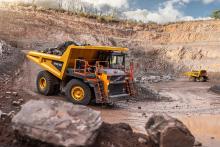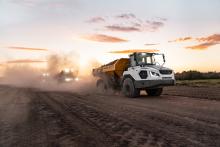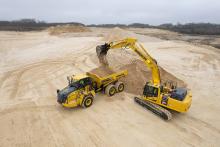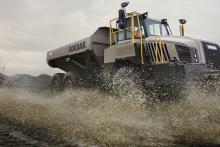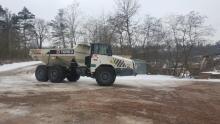
The COVID-19 pandemic has forced most construction equipment manufacturers worldwide to reduce or suspend production at their factories over the last few months.
Around the end of March, in line with its parent company the Volvo Group, articulated hauler manufacturer Terex Trucks decided to temporarily suspend production at its facility in Motherwell, Scotland. The company says this was to ensure the health, safety and wellbeing of its employees, customers and the general public.
Speaking at the end of May 2020, Terex Trucks MD Paul Douglas said that the company is continuing to operate with a small team of dedicated employees who are working to support customers and maintain vital spare parts distribution.
Terex Trucks has recently started to see some OEMs (original equipment manufacturers) gradually bring teams back to work and begin a ‘new normality’ and Douglas adds that building sites are expected to gradually re-open over the next few months.

“Right now, it’s hard to predict exactly what’s going to happen in the global construction sector over the next few months, but we do see cause for optimism,” said Douglas. “The construction industry will be vital to global economic recovery. To kick-start economies, we expect that governments will invest in construction and infrastructure projects as an effective way to create jobs and boost their economies – and there are some key projects on the horizon.”
In the UK OEMs are getting ready for the start of the major High Speed 2 (HS2) infrastructure project, which the government has approved work to start on. Serving eight of Britain’s ten largest cities, this high-speed railway linking up London, the Midlands and the North is one of the most important economic regeneration projects in Britain for decades, which Douglas says is expected to kick-start not just the construction industry but the wider economy.
Douglas predicts that, due to this project alone, the UK could see demand for articulated dump trucks rise by an additional 1,000 machines over the next few years.
“In the first stages of the project, articulated haulers such as our Terex Trucks TA300 and TA400 will be used for preparatory tasks and transporting materials before the main construction work can begin,” he adds. “This includes jobs like vegetation clearance and earthwork for tunnel portals and compound facilities.”
In France, where Terex Trucks is expanding its distribution network and currently has four dealers – The Manu Lorraine Group, Framateq, Promatex and Griset Material – the population has slowly been returning to work during the last of weeks of May and Terex dealers have started up their sales activities again.
Looking ahead, Douglas highlights the Seine-Nord Europe Canal project, an important initiative that is expected to boost the French construction sector as well as the wider economy. This will involve the construction of a 107km inland waterway link extending from France to Belgium, connecting the Seine basin north of Paris to the Rhine basin and the northern European waterway network. For the construction, 55 million m3 of earth will have to be excavated and transported. Douglas says that robust and reliable dump trucks such as Terex Trucks’ own TA300 and TA400 models are a natural choice for this task.
“While I do believe there is cause for optimism, the last few months have, of course, not been easy for OEMs,” he adds. “In the UK, which is the biggest market for articulated trucks in Europe followed by France and Germany, sales of construction and earthmoving equipment fell by 36% in the first four months of the year, compared with the same period in 2019.”
In April, the Construction Equipment Association reported that sales fell by 74% compared to the same month last year.
As the lockdown in the UK came into effect at the end of March, Douglas says it is unfortunately the case that the industry’s sales will take a further dive in the second quarter of the year.
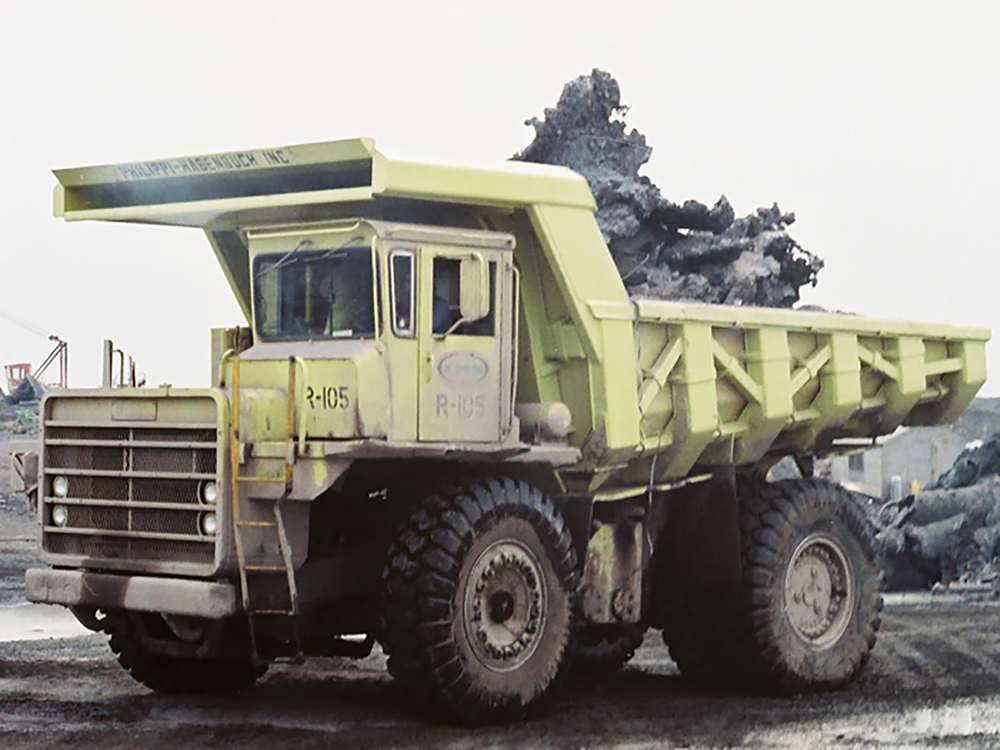
“As construction activity has slowed down throughout Europe during the last few months, the demand for machine rentals has also decreased,” he says. “This has had a significant impact on German rental companies – where renting accounts for 70% of the market activity – as well as the Italian market. In Italy, the rental trade association Assodimi-Assonolo reported that in March, 80% of rental companies experienced a downturn in orders.”
In Asia, which was amongst the places initially hit by the COVID-19 pandemic, the region has been one of the first to reopen its factories. In Korea and China, some construction equipment plants are already back up to full capacity and Douglas says there is a good level of demand. However, it still remains to be seen how this will develop over the next few months.
In Indonesia, for instance, the numbers of registrations for articulated haulers indicate a significant drop in demand. Last year, 177 machines were registered in the first quarter, whereas this year there were only four registrations in the same period. This is a completely different situation to Africa, where Douglas says that the number of registrations has been relatively stable so far.
“In other parts of the world, we are hearing that there won’t be any big projects starting over the next few months,” he adds. “In the Middle East, where many countries have oil-dependent economies, a lot of construction and infrastructure projects have been put on hold. This is due to low oil prices as the financing of construction and infrastructure projects in many Middle Eastern countries is often backed by oil revenues.”
The first two Komatsu HD605-8 dump trucks equipped with Metso Truck Bodies have been delivered to a porphyry quarry in Brabant Wallon, Belgium.
The deliveries by Metso distributor BIA Group are the first to be made in Central Europe and come exactly one year after the launch of the Metso Truck Body at the bauma 2019 fair.
The tough and abrasive rock handled by the Brabant Wallon quarry had a significant impact on the previous conventional truck boxes. On a traditional box, the maximum payload is limited by the high weight of the lining and the box itself. Metso says its Truck Body differs from a standard box by its lighter, but resistant, rounded design in ultra-high-strength steel combined with the Trellex rubber lining. The Finnish quarrying equipment maker says this makes it possible to obtain a 20% to 30% lighter body without sacrificing rigidity.
The Metso Truck Body designed for the Komatsu HD605-8 truck weighs 6 tonnes less than a standard version fitted with a steel liner. According to Metso this weight reduction translates into a 10% additional payload and therefore offers greater efficiency from the first run. Likewise, during empty bucket journeys, the dumper will consume less fuel simply because it is lighter. Due to its rounded shape, less carry-back remains in the body, avoiding the transportation of unnecessary weight.
Off-highway truck customisation company Philippi-Hagenbuch has started using new SSAB Hardox HiTemp steel in its Hot Slag truck bodies.

The new steel is purposely designed to withstand extreme temperature environments and Philippi-Hagenbuch says that it reduces necessary plate thickness while maintaining the product’s service life for increased productivity in processing applications.
“As a true custom manufacturer, every PHIL product is designed to excel in a specific application,” said Josh Swank, vice president of sales and marketing for Philippi-Hagenbuch (PHIL). “In the past, steel mill clients requested a unique HiVol truck body to haul hot slag. Our engineers responded with the Hot Slag Body. Now, with the new HiTemp steel from SSAB, we can provide the same strength and durability with less steel, maximizing payload potential and providing our clients with a better product.”
The Hot Slag Body is comprised of two components — an exoskeleton superstructure, which does not come in contact with molten material, and load-containing pieces that do.
These pieces form an overlapping structure that is loosely strapped around the body of the exoskeleton to contain the hot slag during operation. This is designed to allow for differential expansion and contraction, where a traditional body would buckle under such extreme heat. When transporting molten material, the pieces expand and contract without breaking welds, binding up or warping. When a piece is damaged or worn out, it can simply be replaced without any structural welding requirements.
Following its acquisition of fellow Italian company Perlini in 2018, Cangialeoni Group has “rebirthed” the brand (now called Perlini Dumpers) from the start of 2020 with the expressed aim of returning it to the elite group of rigid dump truck (RDT) manufacturers.
This strategy has led to the company moving from the exclusively internal production of all components to a partnership with a group of twenty-three local suppliers and to the development of a new truck designed for the most advanced customer needs.
Perlini Dumpers will continue to produce dump trucks at the historic Perlini headquarters in Gambellara, Vicenza. The current range consists of three models, with 40, 65 and 95 tonnes of loading capacity and powered by two types of engines: for European Union users and for users in countries outside the EU.
The just-launched Perlini RDT features a new Scania Stage V engine and a new Avtec transmission.
The 65-tonne model is due to be officially presented at the next SAMOTER exhibition, scheduled to take place in Verona from 21-25 October 2020.
The RDT hauler is designed to comply with recently introduced regulations on exhaust emissions; the new Scania Stage V engine is designed to meet the most severe requirements in this area, providing low fuel consumption and a high torque.
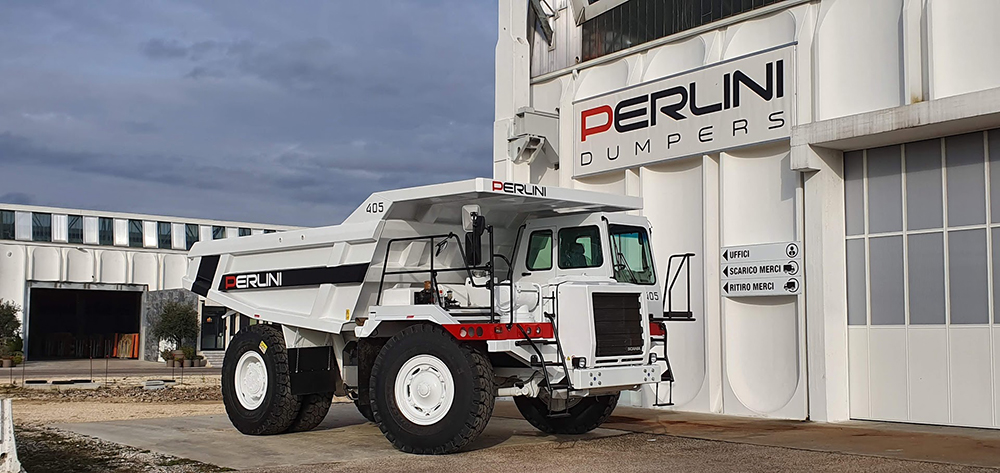
The haulers also feature an electronic weighing system, GPS locator, control of machine parameters and production monitoring in real time, allowing total control of the truck to provide a significant increase in production efficiency.
Cangialeoni Group says that the systems available on the new Perlini trucks mean it is possible to monitor the vehicle and its load at any time. The new electronic transmission control allows the operator to access data in a more comfortable and intuitive way. The selector display provides information on the transmission, allowing the operator to recognise any alarms and codes and integrates some diagnostic tools.
The GPS system collects a range of vehicle data. This information includes location, distance travelled, switchboard status (on or off), body activation (lifted or low), voltage in volts of the internal battery, primary power (on-off), GPS status (on-off), detection of CAN BUS data (non-invasive connection), environment temperature, detection of aggressive driving (acceleration, braking and sharp curves), remote commands (engine block), alert (alarm setting with notification via web and/or email), alarms (including area entry and exit, power failure, GPS/GPRS signal absence) and maintenance (checking of scheduled deadlines with reminder reception on a km/hour basis).
Komatsu Europe has launched its new HD785-8 Rigid Dump Truck. Built for mining and quarrying applications, the HD785-8 has a Stage V Komatsu SAA12V140E-7 engine (849kW/1,140hp) and a payload capacity of 92.2 tonnes.
The EU Stage V after-treatment solutions use dual Komatsu diesel particulate filters (KDPF) – most regeneration is performed passively, with no action required from the operator and no interference to machine operation. There is no selective catalytic reduction (SCR), and diesel exhaust fluid (DEF), or AdBlue, is not required.
“The new HD785-8 proposes excellent operator comfort, great travel performance and the well-known Komatsu reliability of the previous model,” said Juuso Ahola, product manager at Komatsu Europe.
Key machine metrics for utilisation, production and machine health can be accessed remotely via the KOMTRAX telematics system or on the machine through the upgraded machine monitor.
The HD785-8 has a seven-speed, fully automatic transmission with two selectable reverse speeds. The Komatsu Advanced Transmission with Optimum Modulation Control System (K-ATOMiCS) is designed to ensure smooth clutch engagement for a comfortable ride and reduced material spillage.

The HD785-8 delivers fast acceleration out of the pit and has excellent travel performance on grade.
Wet multiple disc brakes on all wheels provide great downhill brake-retarding performance.
With a tight turning radius of 10.1 m the HD785-8 provides exceptional manoeuvrability when waiting to be loaded and positioning to dump. The Komatsu Traction Control System (KTCS) is standard on the HD785-8. KTCS automatically applies pressure to independent brake assemblies for optimum traction in various ground conditions.
Caterpillar has introduced the 725 articulated truck whose features include a ‘next-generation’ cab, a powerful engine meeting current emissions standards and automatic features to increase productivity.
The new 24-tonne payload truck is designed to build on the reliability and durability of the 725C2, offering increased performance for customers engaging in heavy and general construction, mining, quarry and aggregates, landfill, waste and industrial applications.
The articulated truck is the first to display the new Cat trade dress and offers improved lighting for easier night work with optional high-level LED, high-intensity lights, LED machine-width position marking lights and access lights on both machine sides.
The 20% larger cab features infrared blocking glass to reduce solar heating inside, while sliding windows increase ventilation and enable communication with the loading tool and workers on the ground. More vents positioned toward the operator with the new automatic climate control (HVAC) system deliver improved heating or cooling efficiency inside the cab.
The new 725 powertrain includes the Cat CX31 six-speed transmission with advanced features designed to deliver smoother shifting, up to 8% greater acceleration and increased speed on grade of as much as 9%. Advanced Automatic Traction Control removes all manual traction control decisions from the operator and automatically changes the differential lock engagement level on-the-go to continuously maintain traction, resulting in improved cycle times, increased productivity and reduced tyre wear.

